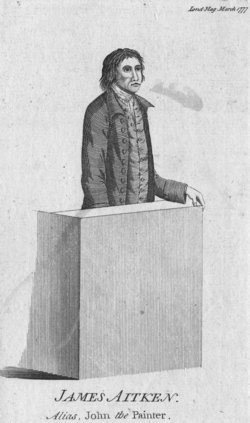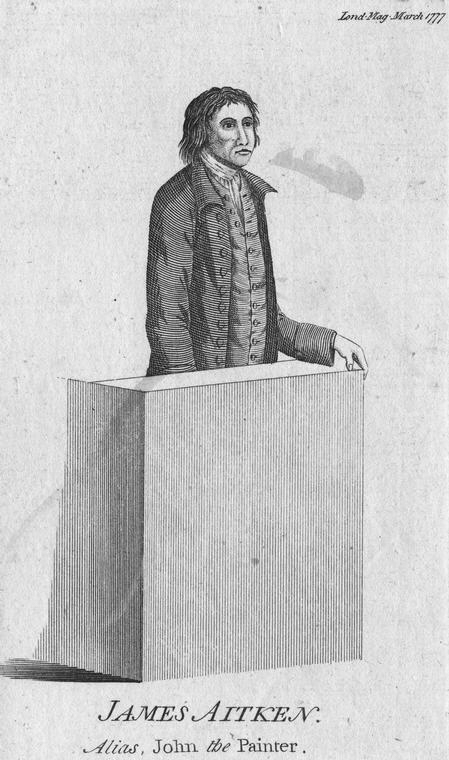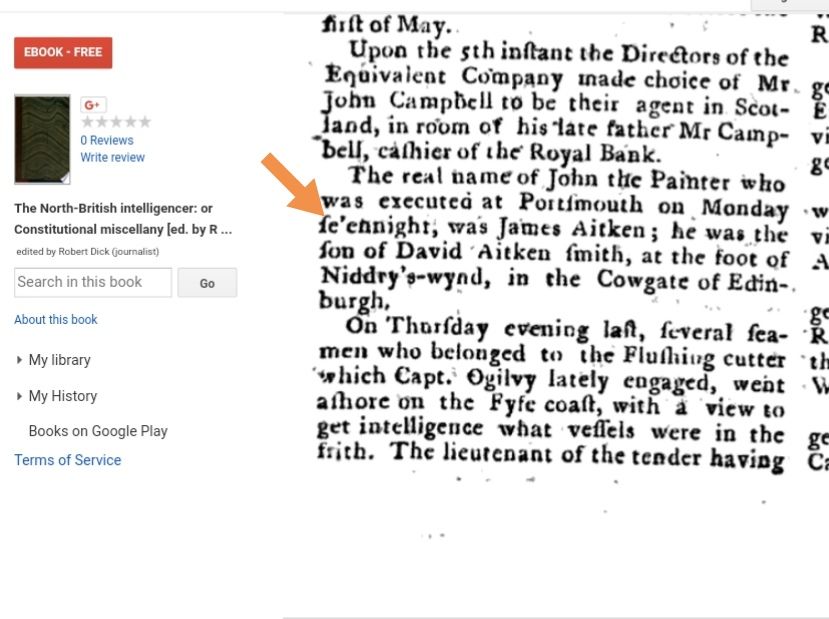Known as "John The Painter"
He had been a misfit and vagabond traveling throughout England and to the American Colonies committing crimes like theft, robbery and one admitted rape, became known as a terrorist after several fires set in British Royal Naval shipyards.
While in America he became opposed to the British government and thought he would be helping the Americans by doing damage to the British Navy by setting fires. He was caught and before 20,000 people, hung from the mizzenmast of HMS Arethusa for arson in royal dockyards after he was caught setting the rope house at Portsmouth shipyard on fire. The mast was struck from the ship and re-erected at the dockyard entrance so as many people as possible could watch the execution. It was the highest gallows ever to be used in an execution in England.
As was the custom of making an example of criminals, his body was tarred and hung from a newly built gibbit at Fort Blockhouse, the point at the entrance to the harbor, for several years. Tar was used to slow decomposition of a body and they would be hung in irons. Some bodies treated this way were spirited away by friends but he had none. Others were chipped away at by goulish souvenir hunters. To discourage this the authorities would drive hundreds of nails into the supporting poles.
Criminal penalty: Death
Criminal status: Executed
Cause of death: Hanging
Son of David Aitken, Whitesmith/ Blacksmith of Cowgate Edinburgh. The eighth of 12 children born to an impoverished blacksmith in the slums of Edinburgh old town. Aitken seemed preordained, by both temperament and background, for a life of petty crime. What may have changed him was an odd confluence of circumstances — a stammer, which may have fired in him an ambition to "be above the ordinary"; the early death of his father, which assured him a good education at the charitable school of George Heriot's Hospital; a charitable school for impoverished children which was founded to care for the "puir, faitherless bairns" (Scots: poor, fatherless children) of Edinburgh; a love of books, which may have introduced him to Enlightenment ideas and perhaps made him a radical. Left school at 14.
There are a lot of maybes here, and there ..
Painter who was executed at Portsmouth on Monday se'ennight, was named Aitken; he was the son of David Aitken smith, at the Foot of Niddry's-wynd, in the Cowgate of Edinburgh.
Aitken's only real legacy was the American High Treason Bill, whose strictures against American nationals who might have been involved in terrorist activity strike a strange and compelling chord today.
Some sources:
Biography: John The Painter by Jessica Warner
https://web.archive.org/web/20060103162916/
http://www.timesonline.co.uk/article/0,,2102-1476331,00.html
https://wellcomecollection.org/search/works?query=%22Aitken,%20James,%201752-1777.%22
The London Magazine, Or, Gentleman's Monthly Intelligencer, Volume 46 March 1977
The North-British intelligencer: or Constitutional miscellany edited by Robert Dick (journalist) pg383
Known as "John The Painter"
He had been a misfit and vagabond traveling throughout England and to the American Colonies committing crimes like theft, robbery and one admitted rape, became known as a terrorist after several fires set in British Royal Naval shipyards.
While in America he became opposed to the British government and thought he would be helping the Americans by doing damage to the British Navy by setting fires. He was caught and before 20,000 people, hung from the mizzenmast of HMS Arethusa for arson in royal dockyards after he was caught setting the rope house at Portsmouth shipyard on fire. The mast was struck from the ship and re-erected at the dockyard entrance so as many people as possible could watch the execution. It was the highest gallows ever to be used in an execution in England.
As was the custom of making an example of criminals, his body was tarred and hung from a newly built gibbit at Fort Blockhouse, the point at the entrance to the harbor, for several years. Tar was used to slow decomposition of a body and they would be hung in irons. Some bodies treated this way were spirited away by friends but he had none. Others were chipped away at by goulish souvenir hunters. To discourage this the authorities would drive hundreds of nails into the supporting poles.
Criminal penalty: Death
Criminal status: Executed
Cause of death: Hanging
Son of David Aitken, Whitesmith/ Blacksmith of Cowgate Edinburgh. The eighth of 12 children born to an impoverished blacksmith in the slums of Edinburgh old town. Aitken seemed preordained, by both temperament and background, for a life of petty crime. What may have changed him was an odd confluence of circumstances — a stammer, which may have fired in him an ambition to "be above the ordinary"; the early death of his father, which assured him a good education at the charitable school of George Heriot's Hospital; a charitable school for impoverished children which was founded to care for the "puir, faitherless bairns" (Scots: poor, fatherless children) of Edinburgh; a love of books, which may have introduced him to Enlightenment ideas and perhaps made him a radical. Left school at 14.
There are a lot of maybes here, and there ..
Painter who was executed at Portsmouth on Monday se'ennight, was named Aitken; he was the son of David Aitken smith, at the Foot of Niddry's-wynd, in the Cowgate of Edinburgh.
Aitken's only real legacy was the American High Treason Bill, whose strictures against American nationals who might have been involved in terrorist activity strike a strange and compelling chord today.
Some sources:
Biography: John The Painter by Jessica Warner
https://web.archive.org/web/20060103162916/
http://www.timesonline.co.uk/article/0,,2102-1476331,00.html
https://wellcomecollection.org/search/works?query=%22Aitken,%20James,%201752-1777.%22
The London Magazine, Or, Gentleman's Monthly Intelligencer, Volume 46 March 1977
The North-British intelligencer: or Constitutional miscellany edited by Robert Dick (journalist) pg383
Advertisement
Records on Ancestry
Sponsored by Ancestry
Advertisement



